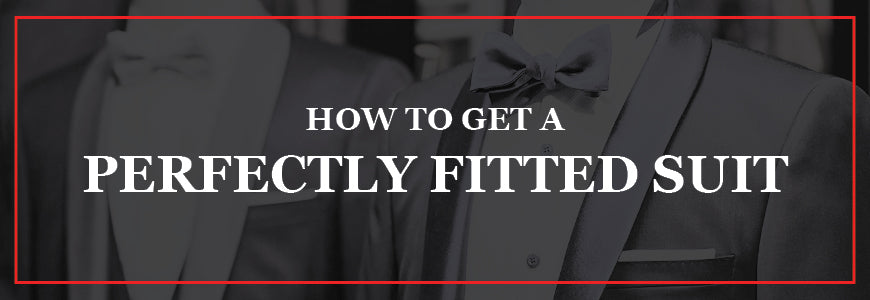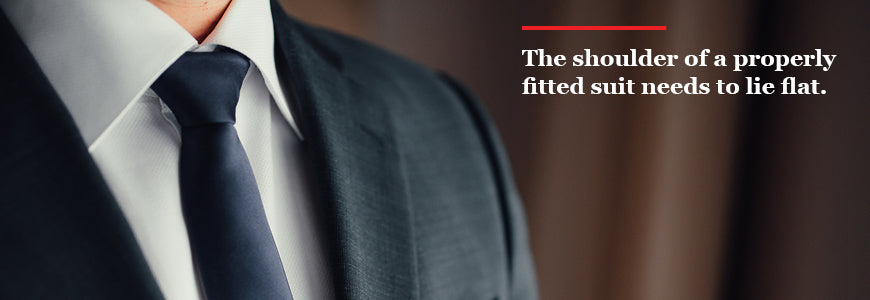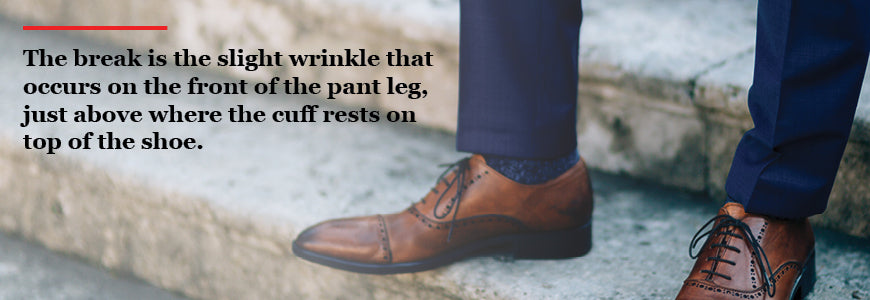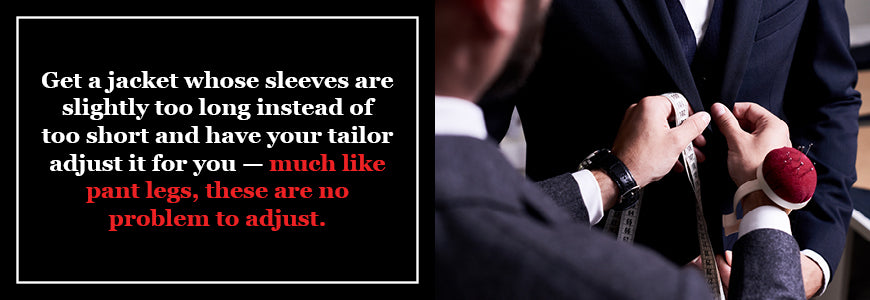Your Cart is Empty
- Home
- Shop Now
- About Us
- Blog
- Gift Cards
- Weddings
- Schedule Appointment
- Our History
- Suits
- Free Custom Tailoring
- Contact Us
- 1-210-226-2487
- Login

Few things speak louder than a well-fitted suit. It is the epitome of class, elegance and confidence, and the person wearing it automatically has an elevated baseline of charisma. Those of us who have attended the school of James Bond or Sterling Archer are already aware of the power it holds.
A poorly fitted suit achieves an effect of the same magnitude, but in the opposite direction. Imagine a suit that is baggy around the ankles, too wide at the shoulders and bunched around the middle. Instead of charisma, such a suit emanates an aura of unsavoriness. Is this a fair judgment? Not at all. Do people make it anyway? Absolutely.
The answer to all of this is to get a suit that fits you perfectly. With it, you too can achieve that forcefield of manly allure that graces the noblest of gentlemen. Here is a guide on how to achieve that look, starting with an understanding of how suits fit and culminating in the best events to show them off.
Historically, yes. That's why looking impeccable has largely been a luxury available to the rich throughout the centuries. However, the same is not true today. While a larger budget will always result in nicer clothing, there are plenty of suits in different price ranges that can be tailored to look sharp.
Penner's throws the ultimate wrench in this historical wheel of exclusivity. Our retail center in downtown San Antonio features a staff of seven on-duty tailors who will perform complimentary alterations for customers. When you shop here, tailored suits are no longer out of reach.
When you get tailored, you'll need to stand in what is called your "natural" stance. This implies good posture: feet shoulder-width apart, a straight back, shoulders slightly back, arms by your side and no slouching. You should also get tailored while wearing the dress shoes you'll be wearing with the suit.
Of course, this stance may feel like the furthest thing from natural. However, this is the posture you should strive for. And when you look as good as you will in your newly tailored suit, you'll want to stand tall and proud anyway.
Once you've gotten your posture down, you are ready to identify the elements of a great fit. Here they are:
Our shoulders are interesting things from the standpoint of clothing — they are flat and yet full of curves, they move in a circular motion and they effectively provide a bunching point for clothing when you raise your arms. Luckily, there is a method to achieving the perfect fit for your suit's shoulder.
The shoulder of a properly fitted suit needs to lie flat. One of the first signs to look for is either a dip or bow in the shoulder line, which can indicate it is too small or too big, respectively. The seam where the sleeve meets the body should rest right where the arm joins the shoulder. Another thing to aim for is matching the length of the seam along the suit's shoulder to the length of the bone in your shoulder.

There are a few signs the suit is not the right fit for you and cannot be tailored to fit. One is if the seam where the sleeve joins the jacket is bunched high up your shoulder, or if it is hanging a good way down the front side of your arm. In these cases, try the next size suit. Also look for divots below the shoulder seam.
Because shoulders are quite difficult to make tailored adjustments to once the suit is made, this should be the first sign you look for to see if the jacket is a good fit. If you do purchase a suit with improper shoulder lengths, it is unlikely alterations will help correct the problem fully.
The seat of your suit's pants gets a lot of use from sitting, kneeling and general movement. Having it fit properly is important for both comfort and appearance. Because this area requires a good deal of flexing, a proper fit is also integral to the lifespan of the pants to prevent splitting.
Due to the huge variety of shapes in our rear ends, it is important to find a pair of pants that fits properly. How should suit pants fit? The seat should hang smoothly over your rear end, contacting, but not bunching, your underwear. It should neither hang down the backs of your thighs nor stretch tight across your rear.
Two telltale signs of a poorly fitted seat are tension wrinkles under the buttocks, which occur when the seat is too tight, or by sagging fabric hanging down the back of the legs when the seat is too loose.
When you try on a pair of pants, make sure the seat is approximately right — a tailor can only reduce the size of it so far before pockets start to wind up in the wrong place. Note tailors can generally tighten a seat more easily than they can expand one, unless a pair of pants happens to include extra fabric in the inside. That is unusual, though. That's why it is a better idea to choose pants that are slightly too loose than slightly too tight.
Changing the length of trousers is one of the easiest tailoring adjustments on the entire suit. For this reason, the length of a pant leg should not be a huge concern when choosing pants, provided they are not exceptionally short. This allows more wiggle room in choosing a pair of trousers with the right seat shape. For this reason, you will find many trousers unhemmed when you buy them. The seller assumes a tailor will be adjusting the length regardless.
That brings us to an essential part of the trouser leg: the break. This is the slight wrinkle that occurs on the front of the pant leg, just above where the cuff rests on top of the shoe.

The break is a crucial part of the pant leg. It should be there, but there should only be one and it should be around one inch — too many wrinkles mean the pant leg is too baggy. The cuff should be resting on the shoe, however. If the cuff is leaving your sock visible, the pant leg is too short.
To compensate for the shape of the shoe, the back of the pant leg will be longer than the front. That is only a slight difference in length, though, and should be just enough for it to cover your heel.
First off, let's cover the important ground rule of suit jackets: you button the jacket when you stand up and unbutton it when you sit down. As your legs draw upward when you sit, they put tension on the buttons and can cause uncomfortable strain. To recap the buttoning rules when standing, you should never fasten the bottom button, always fasten the middle button and only occasionally fasten the top button.
To be a good fit and not a fashion disaster, you need the jacket closure to work with the middle button. Try buttoning this button and observe to see if the two sides the of the jacket meet neatly in the middle. There should be a slight "waist" in the coat when you button it — that is, a light narrowing around the center of the coat — but the bottoms should not flare outward. The lapels should also not leave your body.
The middle button should not be difficult to fasten. Once buttoned, it is acceptable for the bottom of the jacket to show a bit of an opening, though not enough to show the shirt above your pants. The jacket should not have any wrinkles spreading out from the point of fastening. One of the biggest signs to look for is an "X" of wrinkles emanating out from a fastened button.
Your tailor can make some adjustments to the jacket's waist to make this section fit, but it is an area of the suit that cannot undergo significant alteration. Start with a jacket that looks relatively good untailored, instead of expecting miracles from the tailor.
You can follow the adage "a half-inch of linen" when gauging your jacket's sleeve length. This phrase refers to the shirt you wear under your jacket, of which you should be able to see about half an inch peeking out from the end of your jacket cuff. Keep in mind this is only a guideline, and you can change the amount visible as suits your style.
The important thing is to make sure the sleeve of the jacket doesn't ever reveal the cuff of the shirt sleeve itself. The cuff should always be hidden under the jacket sleeve. Conversely, the jacket sleeve should never completely obscure the sleeve of the shirt.
The majority of the time, a jacket sleeve that ends over the bone on top of the wrist is the right length. However, arms vary quite a bit between people. Get a jacket whose sleeves are slightly too long instead of too short and have your tailor adjust it for you — much like pant legs, these are no problem to adjust.

When you are testing out your suit, also be sure to go through a sampling of motions. Extend your arm like you would shaking someone's hand, then raise your arm like you are asking a question. The sleeve should ride up your arm and return to its hanging position when your arm returns.
Length is one of the most important parts of how a suit should fit. If a jacket is too short, it looks silly, and a suit jacket that's too long can look like a badly made tuxedo.
A properly fitted jacket should hang over the top of the buttocks to the point where they are vertical. You know your jacket is too short if the bottom edge of it is resting on top of your buttocks, with a tiny flare in the back. The front should rest nearly level with the crotch of the pants. The front is more precise than the back — one can get away with a back that is slightly shorter or longer.
You can use your hands to figure out where the sides of the jacket should hang. If you let your arm hang naturally by your side, the jacket's lower edge should coincide with the point just inside where your fingers join your palms. A jacket that hangs past your hands is irredeemably long and should be exchanged for a shorter jacket. You'll probably have around one to two inches of wiggle room to play with in adjusting the length of your jacket.
Last but not least is the collar. A properly fitting collar should lay against the collar of your shirt underneath, and your shirt collar should lay against your neck. If they are not touching, you know the fit is not quite there yet.
In general, it is not difficult to spot a collar that isn't properly fitted, but it is sometimes tricky to troubleshoot the problem — there are a lot of variables that can affect how a collar lies. One telltale sign a jacket collar is too loose is when it sits away from the back of your neck and doesn't touch your shirt collar.
A collar that is too tight is trickier to spot. The reason for this is that most of the problem lies in the back of the jacket. As your head swivels from side to side, a collar that is too tight will bunch and wrinkle both the suit jacket and the underlying shirt. You can test this in a mirror to determine if yours is too tight.
To account for this, a tailor may conclude the neck size isn't right for you. They may also find that the shoulder is improperly sized, the back panel is not quite large enough or the jacket is designed for someone with a different stance than you.
Make sure to test several jacket sizes to find the right collar fit, as it is one of the more laborious fitting issues to remedy.
There are plenty of occasions where suits of various formalities should make an appearance. Here are some events where suits would be appropriate, ranging from most formal to most casual:
If you are looking for the perfect suit to fit you, shop online or in person at Penner's. We offer an 8,000-foot dedicated retail space in downtown San Antonio, Texas, as well as an online catalog offering a wide variety of stylish suits.

Our in-house tailors make getting a tailored suit easy — and at no additional cost, it saves you a lot of money. Let us show you why we have been an industry leader in fashion for the past century. Contact us with any questions.